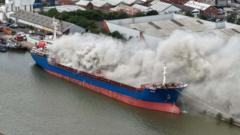What Caused the Massive Ship Fire Sending Smoke Billowing Across the City?

Understanding the Hull Ship Blaze: A Comprehensive Overview
On a seemingly ordinary day, a significant incident unfolded at Albert Dock in Hull, capturing the attention of local residents and emergency services alike. Crews from Humberside Fire and Rescue were called to tackle a blaze on a bulk carrier ship, the Altay, which was carrying scrap metal. The fire, which started in the cargo hold, prompted a swift response from multiple emergency teams, ensuring that all individuals on board were accounted for.
This article delves into the details of this incident, exploring the implications for the local community, the response of emergency services, and the broader context of maritime safety. Whether you're a resident of Hull, a maritime enthusiast, or someone interested in emergency response protocols, this overview provides valuable insights.
What Happened at Albert Dock?
The fire at Albert Dock was reported at 10:22 BST, prompting the immediate deployment of four fire engines, an aerial platform, and the Hull Coastguard Rescue Team. An ambulance was also on standby, highlighting the seriousness of the situation. The presence of multiple emergency services indicates the potential risks associated with such incidents, particularly when dealing with a vessel carrying hazardous materials.
According to reports, the fire originated in the cargo hold of the Altay, a vessel that has been docked in Hull since June 23, 2023. Fortunately, all personnel aboard the ship were accounted for, alleviating concerns regarding casualties. However, the event has raised alarms for nearby residents, leading authorities to advise them to keep windows and doors closed to mitigate the effects of smoke inhalation.
Emergency Response: A Coordinated Effort
Humberside Fire and Rescue's response to the incident underscores the well-coordinated efforts required in emergency situations. The following actions were taken:
- Immediate Response: Fire crews were dispatched promptly to contain the blaze.
- Safety Protocols: Local residents were informed of safety measures, including closing windows and doors.
- Traffic Management: Several streets, including English Street and Wellington Street, were closed to ensure public safety and facilitate the emergency response.
- Collaboration: Associated British Ports assisted in the response by providing information and support to the fire service.
The rapid deployment of resources illustrates the importance of preparation and training in emergency services, especially in maritime contexts where the risks can be significantly heightened.
The Implications for Local Residents and Businesses
For the people living and working in Hull, the incident at Albert Dock is not just a fleeting news story; it has tangible effects on daily life. With smoke plumes visible across the city center and surrounding areas, the impact on air quality and visibility was immediate. Here are several implications for local residents and businesses:
- Health Risks: Exposure to smoke can pose health risks, particularly for vulnerable populations such as children, the elderly, and individuals with pre-existing respiratory conditions.
- Disruption of Daily Activities: Street closures and the presence of emergency services can disrupt local businesses and hinder transportation.
- Community Concerns: Incidents like this can lead to heightened anxiety among residents regarding safety and the handling of hazardous materials in their vicinity.
Authorities are likely to conduct follow-up assessments to evaluate the long-term effects on the community and address any ongoing safety concerns.
Insights into the Altay: The Vessel Involved
The Altay, a bulk carrier that has been docked in Hull, was built in 2006 and operates under the flag of the Marshall Islands. Understanding the characteristics of vessels like the Altay can provide context for the incident:
- Ship Type: Bulk carriers are designed to transport unpackaged bulk cargo, such as grains, coal, or scrap metal, which can present unique risks in case of a fire.
- Safety Features: Modern ships are equipped with various safety features, including fire suppression systems. However, the effectiveness of these systems can be tested during incidents.
- Regulatory Compliance: Ships are subject to international maritime regulations, which dictate safety protocols and emergency response procedures.
Analyzing the Altay's specifications and operational history can provide insights into the potential causes of the fire and the effectiveness of the response measures in place.
Maritime Safety and Fire Management
The Hull ship blaze brings attention to the critical aspect of maritime safety, particularly concerning fire management. The following best practices are essential for minimizing fire risks and effectively managing incidents when they occur:
Best Practices for Fire Safety on Ships
- Regular Training: Crew members should undergo regular training in fire prevention and emergency response protocols.
- Fire Suppression Systems: Ships should be equipped with functional fire suppression systems, including sprinklers and extinguishers, that are regularly maintained.
- Cargo Handling Procedures: Proper procedures must be followed when loading and unloading materials, particularly those that may be flammable.
- Emergency Drills: Conducting regular emergency drills can prepare the crew for potential incidents, ensuring a swift and effective response.
Implementing these best practices can significantly reduce the risk of fire on board ships and enhance the overall safety of maritime operations.
Conclusion: Reflecting on the Incident
The fire at Albert Dock in Hull serves as a reminder of the inherent risks associated with maritime operations. While emergency services responded efficiently to the incident, it raises questions about the preparedness and safety measures in place for vessels carrying hazardous materials. It also highlights the importance of community engagement and communication during emergencies.
As we reflect on this event, it is vital for both maritime authorities and local communities to work together to enhance safety protocols and ensure a swift response to future incidents. Building resilience within the community and fostering a culture of safety can help mitigate the impact of such emergencies.
FAQs
What caused the fire on the Altay?
The exact cause of the fire is still under investigation. It started in the cargo hold where the ship was carrying scrap metal, which can be flammable.
Were there any casualties in the incident?
Fortunately, all personnel on board the Altay were accounted for, and there were no reported casualties.
What measures are being taken to ensure safety after the incident?
Local authorities are likely to conduct thorough assessments and reviews of safety protocols for vessels in the area to prevent similar incidents in the future.
How can residents protect themselves during such incidents?
Residents are advised to keep windows and doors closed to prevent smoke inhalation and to stay informed through local news and emergency services.
As we digest the implications of the Hull ship blaze, it’s crucial to consider how we can enhance safety in our communities. What measures do you think should be taken to improve maritime safety in urban areas? #HullFire #MaritimeSafety #EmergencyResponse
Published: 2025-06-27 12:58:23 | Category: technology



